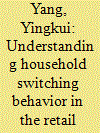| Srl | Item |
| 1 |
ID:
186463


|
|
|
|
|
| Summary/Abstract |
Future retail electricity markets require development to accelerate the net-zero carbon transition. Adopting a customer-centric approach to market design is necessary to fully utilise smart grid technologies. In this perspective we postulate that empowering energy consumers to become an integral component of the smart grid will lead to heightened renewable energy deployment and network flexibility.
|
|
|
|
|
|
|
|
|
|
|
|
|
|
|
|
| 2 |
ID:
166306


|
|
|
|
|
| Summary/Abstract |
This paper examines market structure, regulation, and market performance of the Dutch electricity retail market for households since its opening in 2004. Using data containing monthly prices for all products offered in the Dutch retail electricity markets over the period 2008–2014, we provide quantitative results on the intensity of retail competition and the benefits to consumers. Regulation of the retail electricity market is relatively intensive and encompasses structural measures, contractual restrictions, rules on information provision, price surveillance and market monitoring. In contrast to most other countries, the Dutch regulation includes a kind of price regulation which is that the regulator surveys all new retail prices before market introduction in order to prevent too high retail prices. The Dutch retail electricity market has remained relatively concentrated, with retailers offering an increasing variety of retail products, often using multiple brands. Competition is characterized by product innovation, especially for green energy, rather than price competition on homogenous products. Gross retail margins remain relatively high, as is price dispersion across retailers. The market matured, as evidenced by fewer consumer complaints and higher switching rates.
|
|
|
|
|
|
|
|
|
|
|
|
|
|
|
|
| 3 |
ID:
132675


|
|
|
|
|
| Publication |
2014.
|
| Summary/Abstract |
Deregulation of the Danish retail electricity market nearly a decade ago has produced little consumer switching among suppliers or renegotiation of supplier service contracts. From an energy policy perspective, a certain amount of supplier switching is an important indicator of the success of market deregulation. This argues that poor relationship management and a lack of economic benefits are two critical barriers to consumer switching. Latent class analysis indicates that only 11.4% of consumers are non-switchers, whereas 41.1% can be considered potential switchers and approximately one-half (47.5%) can be considered apathetic consumers. We also discuss the managerial implications for both electricity suppliers and policy makers.
|
|
|
|
|
|
|
|
|
|
|
|
|
|
|
|
| 4 |
ID:
185686


|
|
|
|
|
| Summary/Abstract |
An important goal of EU energy policy is to ensure energy justice during the green transition. The Commission considers the functioning and competitiveness of the retail energy market for households to be proxies for justice and consumer welfare. The European Barriers in Retail Energy Market Project (the EB Project) is instrumental in assessing and ensuring this competitiveness. The EB Project centres on the creation of the Barrier Index (BI), which identifies barriers to entry in the national markets for electricity and gas suppliers across the EU and ranks Member States on the basis of eight indicators. This article critically assesses the reliability of the BI. A faulty BI could lead Member States down the wrong path or towards bad decisions with respect to the regulation of the retail energy market in light of the EU's policy goals. This research identifies problems with the methodology and data collection regarding the construction of the BI indicators in the electricity market specifically. The latter is exemplified through case studies of the Dutch and Portuguese national reports. The identified issues call into question the reliability of the BI as a whole. Possible measures to improve the quality of indicators are discussed in the conclusions.
|
|
|
|
|
|
|
|
|
|
|
|
|
|
|
|